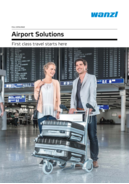Trolley tracking
For optimised fleet management
- Makes trolley supply planning easier
- Reduces inefficient search times for luggage trolleys
- Suitable for both indoor and outdoor use
Every luggage trolley is equipped with an RFID tag, while every depot or collection point has an RFID reader to record data. The airport operator has an overview of the current location of their luggage trolleys at all times. This allows depots to be defined in a more customer-friendly manner, given plenty of space and filled on time. This not only reflects positively on the airport’s general image, but also increases passenger satisfaction, as they can always find a luggage trolley when they need one.
Your contact person

